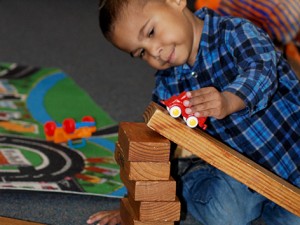Block play – Child
 Block play can take on new forms as your child grows and develops, combining pretend play with more complex structures.
Block play can take on new forms as your child grows and develops, combining pretend play with more complex structures.
Did you know?
Blocks provide opportunities for children to design, plan and build increasingly complex structures to work in with play schemes e.g. building a farm, a house, a city or a fantasy world.
Add language
Use language to comment on more technical aspects of the building design e.g. “That wide base should make a strong building”, and ask a few questions that require thinking and reasoning e.g. “What will happen if ….”, or “How will we join these parts together?”.
Other development
Smaller blocks and those that need to be clicked together require more finger strength and fine motor control. It’s helpful to encourage children to both follow set instructions as well as inventing their own creations.
Children are learning and testing maths and science concepts in working out the number of blocks required and using size and shape concepts to build sturdy or fragile structures.
Building rows or towers of blocks following patterns e.g. red, blue, green, red, blue, green helps focus on position, order and direction. This helps develop key ideas needed for maths.
Variations
Give your child other things to stack e.g. books, boxes, bean bags etc. Talk about how well they stack or if they aren’t good for stacking.
Across the ages
All the activities listed on our “Play Ideas” page can be applied across different age groups. See how block play can be fun for babies, toddlers and playgroups.
Activities listed under “child” are suitable for children 3 years and older. Children of this age enjoy more complex activities where they can develop their skills and use their imagination while playing with friends.

